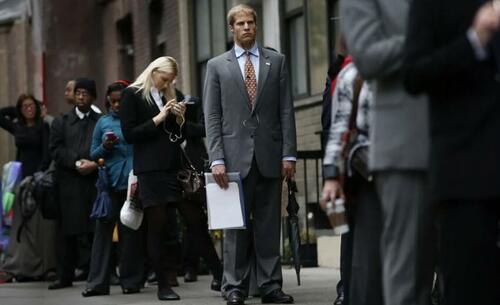Workers Who Had Their Middle-Class Status Offshored By 40-Years Of Neoliberalism Are Finally Vindicated
By Benjamin Picton of Rabobank
An Eye For An Eye
Treasury yields fell yesterday for the first time this week. The 2-year was down 5.5bps to 4.93%, while Brent crude gave up 3% to be sitting well below the $90/bbl again. Crude is sending some interesting signals. It rose every day in the week of Israel’s suspected attack on an Iranian compound in Syria that killed a senior Quds Force commander. Last week crude vacillated between gains and losses as markets awaited the Iranian response and this week, having ‘bought the rumour’ a fortnight ago, markets appear content to ‘sell the fact’.
That’s not to say that there isn’t another geopolitical shoe yet to drop. It seems very likely that there is. Axios reports that the Israeli war cabinet considered giving the IDF the green light to retaliate on Monday, despite urgings from the White House and the G7 for Israel to do nothing. According to Axios, the decision to strike back is already made, only the timing and the scale remains in question. Israel must now run the calculus on how to extract a price from Iran without overplaying its hand and sparking a multi-front war. Iran has threatened that any attack by Israel could be met with a response that is 10x the scale of the weekend attacks and involving more sophisticated weaponry. Clearly, the stakes are high.
Nevertheless, the price action seems to suggest that markets are untroubled by these reports. Commentary in recent days has variously swung between imminent WWIII (unlikely) and “it’s all just for show” (naïve). The entreaties from G7 leaders for Israel to ‘turn the other cheek’ reveal the extent to which Israel’s position is mis-read in the broader West. The post-protestant instinct of European and American leaders to ‘take the win’ on shooting down the vast majority of Iran’s deadly projectiles is at odds with the Israeli viewpoint.
Israel is THE Jewish state. Bibi – and several members of his war cabinet – are old-covenant kinds of guys. “An eye for an eye and a tooth for a tooth” is more than just a millennia-old theological disposition, it is a security imperative for a country attempting to maintain strategic deterrence while surrounded by foes.
So where does that leave markets? Highly irrational in some respects. Risk premia is being rapidly priced out of the energy complex, despite G7 sanctions on Iran, the threat of interruption in the Strait of Hormuz, and news overnight of new US sanctions on Venezuelan oil. Bear-steepening of the Treasuries curve suggests that markets are much more attuned to the ‘game of basis points’ being played in inflation and policy rate projections, rather than the ‘game of pointing missiles at bases’ being played in the Middle East.
To wit, Fed speakers Bowman and Mester have followed up on Powell’s delayed rate cuts admission of a day ago. Mester – usually a hawk – rolled out the back catalogue by saying that the Fed “need[s] to see more data to be sure of [the] inflation path”. Bowman – a definite hawk – said that “progress on inflation may have stalled” and that “time will tell if policy is sufficiently restrictive.”
That last line makes it sounds as if Bowman doesn’t believe policy is sufficiently restrictive. Is she resigned to the idea of the FOMC erring by keeping the Fed Funds rate unchanged while they cross their fingers and toes that three months of rising inflation is just a bump in the road? Perhaps she’s wise to be wary of assurances that “it’s transitory!”
The Fed isn’t the only central bank with difficult decisions ahead. CPI inflation reports for the UK and New Zealand both threw up concerns yesterday, particularly on the trajectory for services inflation.
New Zealand CPI for Q1 came in at 0.6% q-o-q and 4% y-o-y, which is above the RBNZ’s 3.8% forecast. The services component rose from 4.7% y-o-y to 5.3%, while non-tradable inflation (i.e. inflation generated within the country) rose on a quarterly basis from 1.3% to 1.6%. That means that all of the heavy lifting on the headline rate was done by a larger-than-expected fall in tradeable inflation (-0.7% vs expectations of -0.2% q-o-q) that might actually be transitory, given lag effects for energy and freight prices.
Over in the UK the headline inflation rate fell from 3.4% y-o-y to 3.2% in March. The consensus of the Bloomberg survey was for 3.1%, so this was definitely a miss. The median estimate of surveyed economists on the services component was 5.8%, but the actual result came in at 6%, just one-tick lower than the previous month. Our resident BOE watcher, Stefan Koopman, says that this result – taken in conjunction with the prior day’s labour market data – pretty much rules out a rate cut in May. Stefan expects the BOE to cut in August, with two follow-up cuts later in 2024.
Aussie labor market data released earlier today saw some mean-reversion in the headline employment figures. According to the ABS, Australia shed 6,600 jobs in March after gaining 117,600 in February. Rabobank had been expecting 10,000 jobs to be lost – which puts us equal closest to the pin amongst forecasters – but despite a 1-tick rise, the unemployment rate of 3.8% remained below our forecast (and below the market consensus) because of a fall in participation. All-in-all, it was another strong result for the Aussie labour market that does nothing for the view that Australia will be cutting rates imminently.
Herein lies a developing theme. Stronger-than-expected domestic inflation pressures driven by stronger-than-expected labor market outcomes. Is this likely to change? Not if politicians have anything to do with it. Labor demand in the West is being stoked by fiscal expansion as governments scramble to catch up with China on industrial policy.
Overnight Joe Biden announced a tripling of the 7.5% tariff on Chinese steel and aluminium imports and Mario Draghi gave a speech arguing that “radical change is what is needed”; making the case for Europe to respond to Sino-US protectionism with coordinated industrial policy of its own. According to Draghi, failure to do so will inevitably lead to (further) loss of industry to offshore competitors who provide cheaper energy, lower regulatory burdens and state-subsidies.
Even in small, open economies like Australia the fortress mentality is developing. Prime Minister Anthony Albanese’s ‘A Future Made in Australia’ strategy will be a centrepiece of the upcoming May budget, with new government support for green energy, minerals processing and defence. Treasurer Chalmers says that the budget will contain “significant new public investments”, but that there will also be a heavy emphasis on attracting private investment. That sounds similar to Draghi’s contention that government will call the tune, but the private capital will need to be mobilized to cover the investment gap (see Erik-Jan van Harn’s recent report on France’s over-stretched public finances here).
So, real production is back in vogue, and the workers of developed countries who had their middle-class status offshored by 40-years of neoliberalism are vindicated. But talking is much easier than doing, especially when you lack the infrastructure, the expertise or the labor supply to re-industrialize. If the West is serious about responding to security threats and hostile trade practices with ‘an eye for an eye’ in an environment of real constraints, hard decisions will need to be made on how to allocate scarce labour and capital. THAT will be a huge departure from the pre-Covid paradigm.

Tyler Durden
Thu, 04/18/2024 – 13:05

















